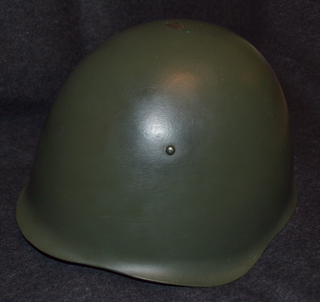
The 2S1 Gvozdika is a Soviet self-propelled howitzer introduced in 1972 and in service in Russia and other countries as of 2023. It is based on the MT-LBu multi-purpose chassis, mounting a 122 mm 2A18 howitzer. "2S1" is its GRAU designation. An alternative Russian designation is SAU-122, but in the Russian Army it is commonly known as Gvozdika. The 2S1 is fully amphibious with very little preparation, and once afloat is propelled by its tracks. A variety of track widths are available to allow the 2S1 to operate in snow or swamp conditions. It is NBC protected and has infrared night-vision capability.

Flecktarn is a family of three-, four-, five- or six-color disruptive camouflage patterns, the most common being the five-color pattern, consisting of dark green, grey-green, red brown, and black over a light green or tan base depending on the manufacturer. The original German five-color pattern was designed for use in European temperate woodland terrain. A three-color variation called Tropentarn is intended for arid and desert conditions; the German Bundeswehr wore it in Afghanistan.

Krystyna Maria Łybacka was a Polish political figure who served in the country's national Parliament (Sejm), since 1991 to 2014 and from October 2001 to May 2004, and was a member of the cabinet, with the title of Minister of National Education.
The karabinek szturmowy wzór 1996 "Beryl" is a Polish 5.56mm assault rifle, designed and produced by the Łucznik Arms Factory in the city of Radom. The rifle replaced the 5.45×39mm FB Tantal used in the Polish Armed Forces; it also replaced the Armed Forces' stock of 7.62×39mm AKM rifles for operational purposes, though reserve and training use of the AKM still continues to a limited degree.

Telewizja Polska S.A., also known in English as Polish Television, is a public service broadcaster in Poland, founded in 1952. It is the oldest and largest Polish television network.

The Land Forces are the land forces of the Polish Armed Forces. They currently contain some 100,000 active personnel and form many components of the European Union and NATO deployments around the world. Poland's recorded military history stretches back a millennium – since the 10th century. Poland's modern army was formed after Poland regained independence following World War I in 1918.

Ckm wz. 30 is a Polish-made clone of the American Browning M1917 heavy machine gun. Produced with various modifications such as greater caliber, longer barrel and adjustable sighting device, it was an improved although unlicensed copy of its predecessor, and was the standard machine gun of the Polish Army from 1931.

MultiCam is a camouflage pattern designed for use in a wide range of environments and conditions which was specifically developed and is produced by American company Crye Precision. As a result of the pattern's effectiveness across disparate environments and regions, it has found extensive adoption globally. Variants of it, some unlicensed, are in use with armed forces worldwide, particularly with special operations units.

The Desert Camouflage Uniform (DCU) is an arid-environment camouflage uniform that was used by the United States Armed Forces from the mid-1990s to the early 2010s. In terms of pattern and textile cut, it is identical to the U.S. military's Battle Dress Uniform (BDU) uniform, but features a three-color desert camouflage pattern of dark brown, pale olive green, and beige, as opposed to the four-color woodland pattern of the BDU. It replaced the previous Desert Battle Dress Uniform (DBDU) which featured a six-color "chocolate chip" pattern of beige, pale olive green, two tones of brown, and black and white rock spots. Although completely phased out of frontline use in the U.S. Armed Forces, some pieces and equipment printed in the DCU camouflage pattern are used in limited numbers such as MOPP suits and/or vests.

The U.S. Woodland is a camouflage pattern that was used as the default camouflage pattern issued to the United States Armed Forces from 1981, with the issue of the Battle Dress Uniform, until its replacement in the mid to late 2000s. It is a four color, high contrast disruptive pattern with irregular markings in green, brown, sand and black. It is also known unofficially by its colloquial moniker of "M81" after the Battle Dress Uniform it was first used on, though this term was not officially used by the U.S. military.

Poland–North Korean relations are foreign relations between Poland and North Korea.

Strichtarn was a military camouflage pattern developed in East Germany and used from 1965 to 1990. The pattern was also used by several other militaries and non-state forces, notably in Africa.

The Wz. 93 Pantera pattern has become the standard camouflage of the Polish Armed Forces. It is the successor of the wz. 89 Puma pattern, and entered service in 1993. It differs from Puma in having stronger contrast, resulting in better disruptive camouflage.

The Wz. 68 was an overprint on cotton fabric in protective colors, which are camouflage, used for sewing military uniforms for Polish People's Army, Milicja Obywatelska, Prison Guards, Policja and Polish Fire Department. It was produced in 1969–1989. Moro replaced the older camouflage pattern wz. 58, called "deszczyk". Moro was replaced in 1989 by Wz. 89 Puma.

The Wz50 also known as M50 is a steel combat helmet used by Poland from its introduction in 1950 to its replacement by the Hełm wz. 67 in 1967. The helmet would be widely exported to a number of Arab countries for its low price. Early pre-production helmets by a double riveted chinstrap and cow skin leather liner. All models of helmet would include an maker and manufacture stamp

Hełm wz. 63 - Polish steel helmet designed for airborne troops introduced in the 1960s. In the Polish Army, wz. 63 helmet was replaced by the HP-03 helmet in 2015.

The Hełm wz. 67 is a combat helmet used in the Polish People's Army and in the Polish Armed Forces to this day.

The hełm wz. 2005 is a combat helmet of the Polish Armed Forces used since 2006.

The Hełm wz. 93 is a combat helmet that was used by the Polish Army from 1993 until 1985, when it was succeeded by the wz. 2000 helmet.




















